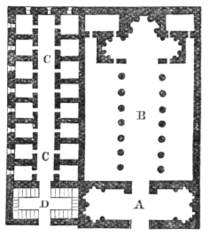amazing. Before the Council of Constance, A.D. 1415, no fewer than 15,070 abbeys had been established of this order Benedictine.alone. The buildings of a Benedictine abbey were uniformly arranged after one plan, modified where necessary (as at Durham and Worcester, where the monasteries stand close to the steep bank of a river) to accommodate the arrangement to local circumstances. We have no existing examples of the earlier monasteries of the Benedictine order. They have all yielded to the ravages of time and the violence of man. But we have fortunately preserved to St Gall.us an elaborate plan of the great Swiss monastery of St Gall, erected about A.D. 820, which puts us in possession of the whole arrangements of a monastery of the first class towards the early part of the 9th century.

Fig. 2.—Plan of Coptic Monastery.
A. Narthex.B. Church.
C. Corridor, with cells on each side.
D. Staircase.
This curious and interesting plan has been made the subject of a memoir both by Keller (Zürich, 1844) and by Professor Robert Willis (Arch. Journal, 1848, vol. v. pp. 86-117. To the latter we are indebted for the substance of the following description, as well as for the plan, reduced from his elucidated transcript of the original preserved in the archives of the convent. The general appearance of the convent is that of a town of isolated houses with streets running between them. It is evidently planned in compliance with the Benedictine rule, which enjoined that, if possible, the monastery should contain within itself every necessary of life, as well as the buildings more intimately connected with the religious and social life of its inmates. It should comprise a mill, a bakehouse, stables and cow-houses, together with accommodation for carrying on all necessary mechanical arts within the walls, so as to obviate the necessity of the monks going outside its limits.
The general distribution of the buildings may be thus described:—The church, with its cloister to the south, occupies the centre of a quadrangular area, about 430 feet square. The buildings, as in all great monasteries, are distributed into groups. The church forms the nucleus, as the centre of the religious life of the community. In closest connexion with the church is the group of buildings appropriated to the monastic life and its daily requirements—the refectory for eating, the dormitory for sleeping, the common room for social intercourse, the chapter-house for religious and disciplinary conference. These essential elements of monastic life are ranged about a cloister court, surrounded by a covered arcade, affording communication sheltered from the elements between the various buildings. The infirmary for sick monks, with the physician’s house and physic garden, lies to the east. In the same group with the infirmary is the school for the novices. The outer school, with its headmaster’s house against the opposite wall of the church, stands outside the convent enclosure, in close proximity to the abbot’s house, that he might have a constant eye over them. The buildings devoted to hospitality are divided into three groups,—one for the reception of distinguished guests, another for monks visiting the monastery, a third for poor travellers and pilgrims. The first and third are placed to the right and left of the common entrance of the monastery,—the hospitium for distinguished guests being placed on the north side of the church, not far from the abbot’s house; that for the poor on the south side next to the farm buildings. The monks are lodged in a guest-house built against the north wall of the church. The group of buildings connected with the material wants of the establishment is placed to the south and west of the church, and is distinctly separated from the monastic buildings. The kitchen, buttery and offices are reached by a passage from the west end of the refectory, and are connected with the bakehouse and brewhouse, which are placed still farther away. The whole of the southern and western sides is devoted to workshops, stables and farm-buildings. The buildings, with some exceptions, seem to have been of one story only, and all but the church were probably erected of wood. The whole includes thirty-three separate blocks. The church (D) is cruciform, with a nave of nine bays, and a semicircular apse at either extremity. That to the west is surrounded by a semicircular colonnade, leaving an open “paradise” (E) between it and the wall of the church. The whole area is divided by screens into various chapels. The high altar (A) stands immediately to the east of the transept, or ritual choir; the altar of St Paul (B) in the eastern, and that of St Peter (C) in the western apse. A cylindrical campanile stands detached from the church on either side of the western apse (FF).
The “cloister court” (G) on the south side of the nave of the church has on its east side the “pisalis” or “calefactory” (H), the common sitting-room of the brethren, warmed by flues beneath the floor. On this side in later monasteries we invariably find the chapter-house, the absence of which in this plan is somewhat surprising. It appears, however, from the inscriptions on the plan itself, that the north walk of the cloisters served for the purposes of a chapter-house, and was fitted up with benches on the long sides. Above the calefactory is the “dormitory” opening into the south transept of the church, to enable the monks to attend the nocturnal services with

